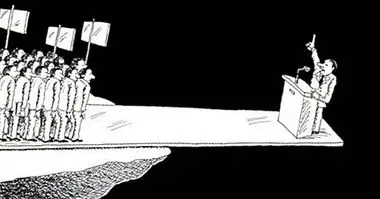The Stanford Prison Experiment by Philip Zimbardo
Philip Zimbardo, the psychologist who challenged human kindness
The motto of Stanford prison experiment devised by the psychologist Philip Zimbardo could be the following: Do you consider yourself a good person? It's a simple question, but answering it requires a little thought. If you think you are a human being like many other people, you probably also think that you do not characterize yourself as a breach of rules twenty-four hours a day.
With our virtues and our shortcomings, most of us seem to maintain a certain ethical equilibrium by coming into contact with the rest of humanity. Partly thanks to this compliance with the rules of coexistence, we have managed to create relatively stable environments in which we can all live relatively well.
Perhaps because our civilization offers a mack of stability, it is also easy to read the ethical behavior of others as if it were something very predictable: when we refer to the morality of people, it is difficult not to be very categorical. We believe in the existence of good people and bad people , and those that are neither very good nor very bad (here probably among the image that we have of ourselves) are defined by automatically moving towards moderation, the point at which neither one leaves very harmed nor seriously harms the rest. Labeling ourselves and others is comfortable, easy to understand and, in addition, allows us to differentiate ourselves from the rest.
However, today we know that the context has an important role at the time of morally orienting our behavior towards others: to prove it we only have to break the shell of "normality" in which we have built our habits and customs. One of the clearest examples of this principle is found in this famous investigation, conducted by Philip Zimbardo in 1971 in the basement of his faculty. What happened there is known as the Stanford prison experiment, a controversial study whose fame is partly based on the disastrous results it had for all its participants.
The Stanford prison
Philip Zimbardo designed an experiment to see how people who had no relationship with the prison environment adapted to a vulnerability situation in front of others. To do this, 24 healthy young men and middle class were recruited as participants in exchange for a pay.
The experience would be developed in one of the basements of Stanford University, which had been conditioned to look like a prison. The volunteers were assigned to two groups by lot: the guards, who would hold the power, and the prisoners, who would have to remain in the basement for the duration of the experimentation period, that is, for several days. As they wanted to simulate a prison in the most realistic way possible, the inmates went through something similar to a process of arrest, identification and imprisonment, and the costumes of all the volunteers included elements of anonymity: uniforms and dark glasses in the case of the guards , and inmate suits with embroidered numbers for the rest of the participants.
In this way an element of depersonalization in the experiment: the volunteers were not specific people with a single identity, but formally they became simple jailers or prisoners.
The subjective
From a rational point of view, of course, all these aesthetic measures did not matter. It was still strictly true that there were no significant differences of stature and constitution between the guards and the inmates, and all of them were equally subject to the legal framework. Further, the guards were forbidden to do harm to the inmates and their function was reduced to controlling their behavior, making them feel uncomfortable, deprived of their privacy and subject to the erratic behavior of their guards. In short, everything was based on the subjective, what is difficult to be described with words but also affects our behavior and our decision making.
Would these changes be sufficient to significantly modify the moral behavior of the participants?
First day in prison: apparent calm
At the end of the first day there was nothing to suggest that anything remarkable would happen. Both the inmates and the guards felt displaced from the role they were supposed to fulfill, in some way they rejected the roles that they had been assigned. However, complications soon began. During the second day, the guards had already begun to see the line disappear. separated his own identity and role that they had to fulfill.
The prisoners, in their condition of disadvantaged people, took a little longer to accept their role, and on the second day a rebellion broke out: they placed their beds against the door to prevent the guards from entering to remove the mattresses. These, as forces of repression, used the gas from the extinguishers to end this small revolution. From that moment, all the volunteers of the experiment they stopped being simple students to happen to be another thing .
Second day: the guards become violent
What happened on the second day triggered all kinds of sadistic behavior on the part of the guards. The outbreak of the rebellion it was the first symptom that the relationship between guards and inmates had become totally asymmetrical : the guards knew with the power to dominate the rest and acted accordingly, and the inmates corresponded to their captors, arriving to implicitly recognize their situation of inferiority as a prisoner who knows himself enclosed within four walls would do. This generated a dynamic of domination and submission based solely on the fiction of the "Stanford prison".
Objectively, in the experiment there was only one room, a series of volunteers and a team of observers and none of the people involved was in a more disadvantageous situation than the others before the real judiciary and before the police trained and equipped to be so. However, the imaginary jail was gradually opening its way to emerge in the world of reality.
The humiliations become the bread of every day
At one point, the vexations suffered by the inmates became completely real, as was also the feeling of superiority of the false guards and the role of jailer adopted by Philip Zimbardo, who had to discard the disguise of investigator and make the office assigned to his bedroom , to be close to the source of problems that he had to manage. Food was denied to certain inmates, they were forced to remain naked or to make a fool of themselves and were not allowed to sleep well. In the same way, jostling, tripping and shaking were frequent .
The Fiction of the Stanford Prison It gained so much power that, for many days, neither the volunteers nor the researchers were able to recognize that the experiment should stop. Everyone assumed that what happened was, in a way, natural. By the sixth day, the situation was so out of control that a remarkably shocked research team had to end it abruptly.
Consequences
The psychological imprint left by this experience is very important. It was a traumatic experience for many of the volunteers, and many of them still find it difficult to explain their behavior during those days: it is difficult to make compatible the image of the guard or the inmate who left during the Stanford prison experiment and a positive self-image
For Philip Zimbardo it was also an emotional challenge. The spectator effect He made for many days the external observers accept what was happening around him and, in some way, consented. The transformation into torturers and delinquents by a group of "normal" young people had occurred so naturally that no one had noticed the moral aspect of the situation, even though the problems had appeared almost at once.
The information regarding this case was also a shock to American society. First, because this kind of simulation directly alluded to one's own architecture of the penal system , one of the foundations of life in society of that country. But more important is what this experiment tells us about human nature. While it lasted, Stanford Prison was a place where any representative of the Western middle class could enter and be corrupted. Some superficial changes in the framework of relationships and certain doses of depersonalization and anonymity were able to overthrow the model of coexistence that permeates all areas of our lives as civilized beings.
Out of the rubble of what had been etiquette and custom before, no human beings emerged who could generate for themselves an equally valid and healthy framework of relationships, but people who interpreted strange and ambiguous rules in a sadistic way.
The reasonable automaton seen by Philip Zimbardo
It is comforting to think that lies, cruelty and theft exist only in "bad people", people that we label in this way to create a moral distinction between them and the rest of humanity. However, this belief has its weak points. Nobody is unfamiliar with stories about honest people who end up corrupting shortly after arriving at a position of power. There are also many characterizations of "antiheroes" in series, books and movies, people of ambiguous morality that precisely because of their complexity are realistic and, why not say, more interesting and close to us: compare Walter White with Gandalf the White.
In addition, in the face of examples of malpractice or corruption, it is common to hear opinions of the style "you would have done the same when you were in your place". The latter is an unsubstantiated claim, but it reflects an interesting aspect of moral norms: its application depends on the context . Evil is not something attributable exclusively to a series of people of a petty nature but is largely explained by the context we perceive.Each person has the potential to be an angel or a demon.
"The dream of the reason produces monsters"
The painter Francisco de Goya said that the dream of reason produces monsters. However, during the Stanford experiment monsters arose through the application of reasonable measures: the execution of an experiment using a series of volunteers.
In addition, the volunteers adhered so well to the instructions given that Many of them still lament their participation in the study . The great flaw of Philip Zimbardo's investigation was not due to technical errors, since all measures of depersonalization and staging of a prison proved effective and all seemed to follow the rules in the beginning. His ruling was that it started from the overvaluation of human reason when deciding autonomously what is right and what is not in any context.
From this simple exploratory test, Zimbardo involuntarily showed that our relationship with morality includes certain quotas of uncertainty , and this is not something that we are able to manage well always. It is our most subjective and emotional side that falls into the trap of depersonalization and sadism, but it is also the only way to detect these traps and connect emotionally with others. As social and empathic beings, we must go beyond reason when deciding which rules are applicable to each situation and in what way they have to be interpreted.
The Stanford prison experiment by Philip Zimbardo teaches us that it is when we renounce the possibility of questioning the mandates when we become dictators or voluntary slaves.
Bibliographic references:
- Zimbardo, P. G. (2011). The Lucifer Effect: the why of evil. Barcelona: Espasa.



















